Adding skirting to your deck is a great way to boost curb appeal and add character to your home. There are many different types of deck skirting material options that can help you achieve the perfect look for your home.
Some deck skirting material options are.
- Vinyl or Acrylic Panels
- Wood
- Composite Wood
- Plywood
- Stucco or Brick Veneer
- Stone or Pavers
- Beadboard or Shiplap Planks
- Fabric Screens
- Live skirting
In this article, we will explore some of the most popular and cost-effective options, as well as tips on how to choose the right material for your needs and how to install it correctly.
What is Deck Skirting and Benefits
Deck skirting is an elevated panel or barrier that is installed around the bottom of a deck.
The purpose is to enclose the space underneath the deck, improving the appearance of the space under the deck and protecting from intruders, pests, and debris.
Different Types of Deck Skirting Material Options
There are many design and material options for deck skirting.
Often they go hand in hand. The material dictated the design of the deck skirting.
But the reverse is also true. The material will affect the design and appearance of your deck skirting.
Along with the deck construction cost and amount of maintenance.
Vinyl or Acrylic Panels: These panels are extremely durable, low-maintenance and cost-effective, with many different colours available and patterns to compliment the exterior of your home.
A common vinyl design option is lattice. Popular designs include diamond, square, and diagonal lattice panels. But recently, decorative panels are available with unique patterns compared to traditional lattice.
Beyond lattice, vinyl can be formed into vertical shiplap planks or horizontal siding. This gives the appearance of wood skirting from a distance but without regular maintenance.
Wood: Wood is a classic look that can be installed vertically or horizontally, depending on the desired effect.
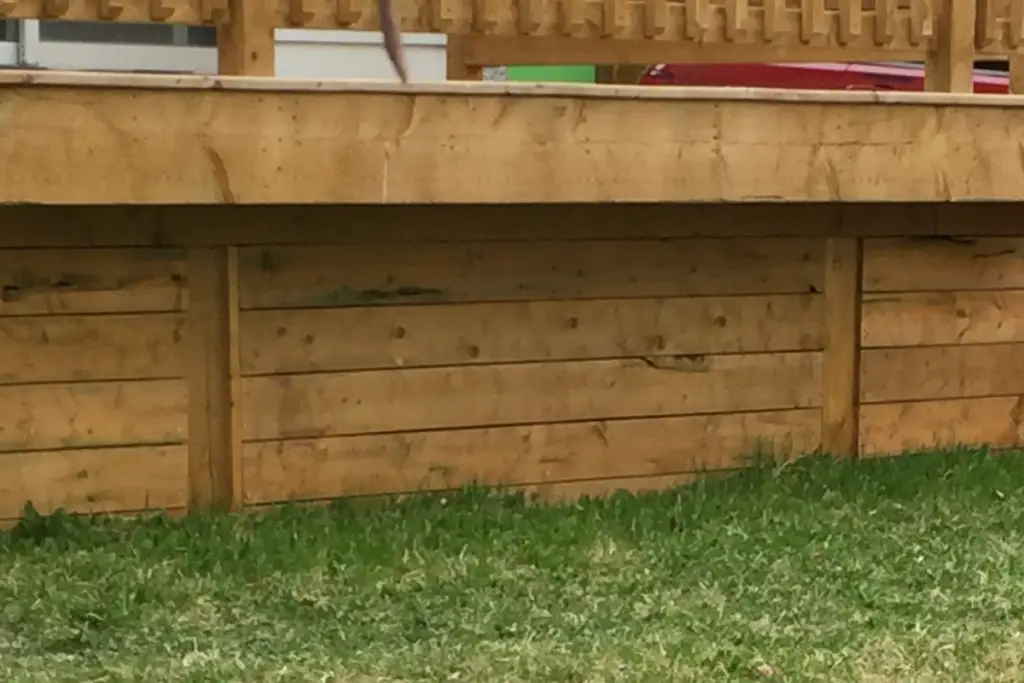
Including Beadboard or Shiplap Planks creating a rustic, cottage-style look. Relatively easy to install and can be painted or stained to match the exterior of your home.
It’s affordable, well at least compared to other material options and adds a traditional charm to the deck space.
Wood does require regular maintenance and upkeep to ensure its longevity. Involving regular cleaning but, more importantly, to prevent rot, it requires regular staining to protect it from the elements.
Composite Wood: Composites are a blend of wood fibres and recycled plastic combined to increase longevity and reduce maintenance but offer the look of wood.
Compliments decks with composite decking.
Many different design options are built out of composite decking, fascia board or a combination.
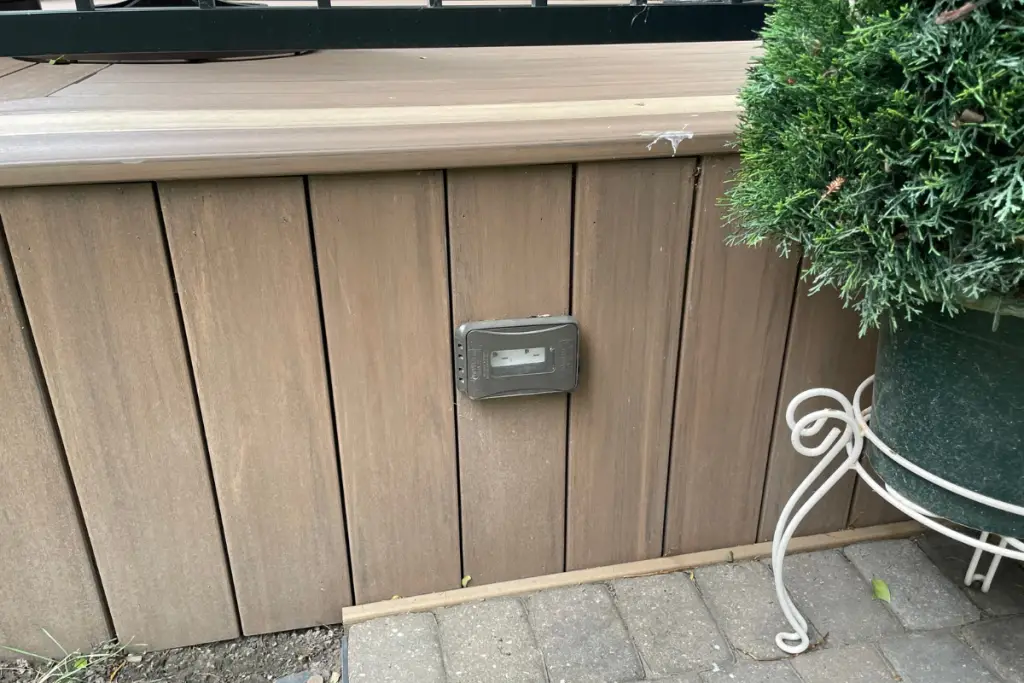
Often requiring a higher level of support than wood skirting. Plan for more substructure framing to hang the composite material from.
But it can be cut, shaped and formed like wood giving you limitless design options from horizontal to vertical plank designs.
Compared to wood skirting it is costly but quickly pays for itself with less maintenance.
Plywood: Plywood is one of the least expensive material options for deck skirting. It is easy to install and can be painted or stained to match the exterior of your home.
One of the biggest challenges of plywood skirting is ventilation. The solid panels prevent airflow under the decking, which is critical to deck longevity.
Stucco or Brick Veneer: A great way to add a unique textural element to your outdoor space. With a high initial cost but similar to composite and vinyl requires almost no maintenance except cleaning.
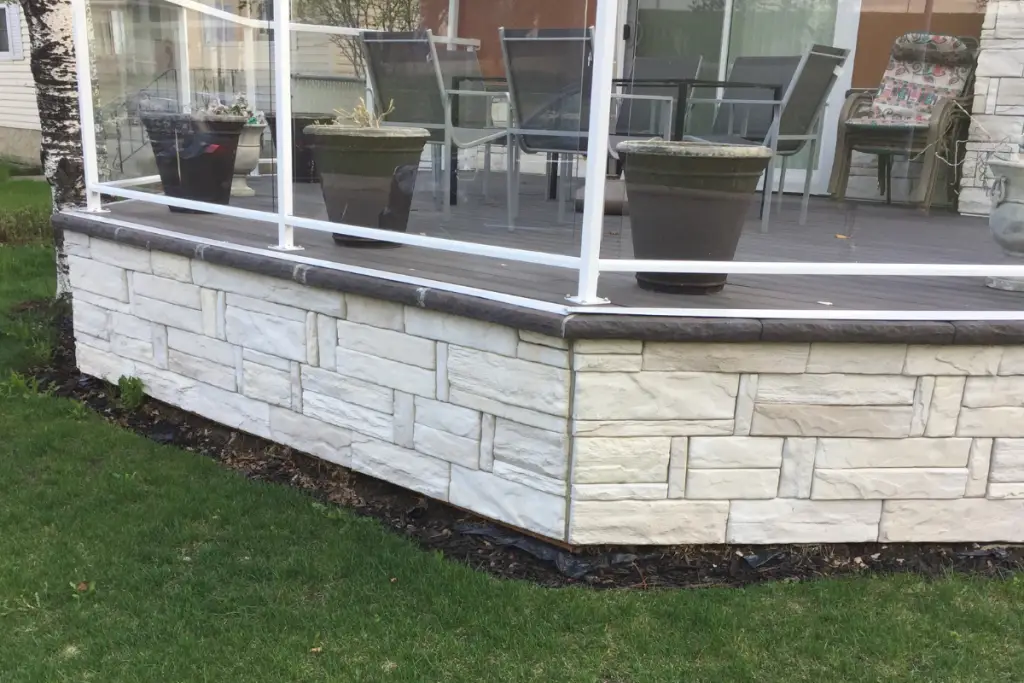
If installed correctly, it will last a lifetime.
Stone or Pavers: Create a natural look that adds character to your deck space. They are also low-maintenance and could outlast your deck.
Stone does require a high level of skill to install properly. Done wrong, they will not last nor look good.
Fabric Screens: Fabric screens partially hide the area under the deck and are relatively cheap and easy to install but are the least durable skirting option.
Live skirting, like strategically planted hedges and bushes, shield your deck and can enhance its appearance.
Although it is not commonly considered a skirting option, it can still add beauty to the lower portion of the deck. It may take some time for the plants to grow fully, but they will make your deck more vibrant once they do. Choosing flowering plants will add seasonal variation and further enhance its beauty.
For the first few years, it is necessary to water the plants until they are fully established regularly. After they are flourishing, they will require annual trimming. Trimming the hedges regularly will help keep them in proper proportions to the deck and maintain their health. Shaping and removing unhealthy branches will enhance the visual appearance of the live skirting surrounding your deck.
Cost of Deck Skirting Materials
With deck skirting materials, staying consistent with the overall deck cost is an important factor to consider.
A quick guide is 5% of the total cost of the deck should be spent on skirting.
A 20 thousand dollar composite deck design skirting costing about $1000.
about $1000.
This does limit your options and, of course, can be ignored, but it’s a good guide.
But it also helps with designing skirting consistent with the entire deck.
If you are building a low-budget pressure-treated deck. It just makes sense that you will use more economical skirting options like vinyl lattice or pressure-treated fence boards.
At the same time, a beautiful low, maintenance composite deck, costing more initially to build, should also have a similar look and cost low-maintenance skirting.
Tips on Choosing the Right Skirting Material for Your Deck
Not every material option is right for your deck.
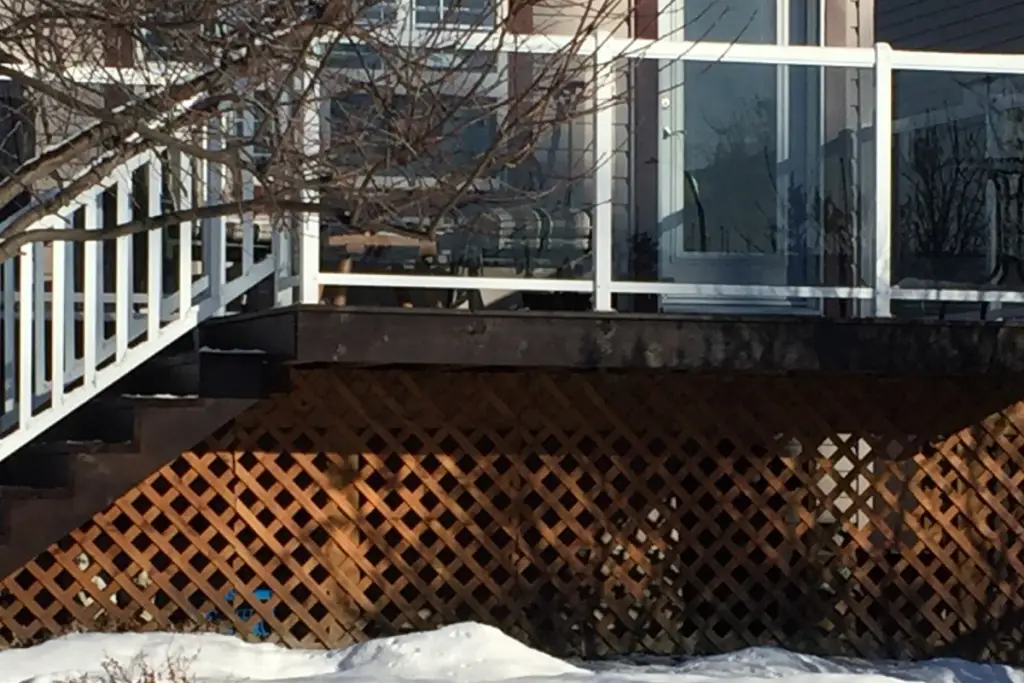
Maintenance, ventilation, and complimentary need to be considered, along with budget consideration.
Let me explain.
It would be pointless to build a deck that requires little maintenance if you have to spend hours every summer maintaining the skirting. If you want more deck time with less work time, choose skirting that will allow you to do that.
On the flip side.
If you are good with taking a few days every summer to refresh your deck. There is no reason to use low-maintenance skirting material, which costs more and cannot be refreshed with the rest of the deck. Choosing skirting material with a similar maintenance schedule.
Ventilation is often overlooked, but it’s critical for the deck’s health that the deck’s substructure can breathe. Open skirting designed like lattice is excellent for this. But can be achieved with wood skirting if gaps between boards are included in the design.
The two worse offenders for limited ventilation under a deck are plywood and stone. Their solid design doesn’t naturally let air under the deck. Requiring intentional vents to be installed.

Appearance is the number one reason for installing skirting, next to keeping rodents out . So selecting material that is complimentary to the rest of the deck.
. So selecting material that is complimentary to the rest of the deck.
Skirting should never be the star of your deck, drawing all the attention. This is often best done with similar material, just like maintenance. Composite decking, having composite skirting. Pressure-treated wood, the same.
A big exception is mason skirting, stone, and brick. These materials are often used to match existing house features and provide a custom look. Enhancing the curb appeal despite not matching. In particular, porches.
How to Install the Deck Skirting Materials Correctly and Efficiently
Installing deck skirting can be done by DIYers or experienced deck builders. Care needs to be taken so that it is installed so as not to lead to problems in the future, such as water damage or warping boards due to lack of proper ventilation. Or worse, rotting out the deck joists.
For wood skirting, it’s important that all materials in contact with the dirt are treated for ground contact  before installation.
before installation.
It’s important to use appropriate fasteners, such as galvanized nails or stainless steel screws, which can better withstand outdoor conditions.
When fastening, different materials, such as vinyl or composite, attach in such a way as to allow for seasonal and sometimes daily expansion and contraction to prevent the material from breaking.

For stone or brick skirting, it’s often best to hire a professional contractor who specializes in this type of material. It needs to be installed correctly to last as long as your deck. Plus, incorrect installation will take longer with less desirable results.
Not saying you can’t, but make sure you talk to experience people and watch tons of YouTube how-to before getting started.
For particular installations and materials, you are best searching up the specific skirting material as each has enough tips and guides for its own article.
Drawbacks or Challenges with Certain Types of Deck Skirting Material
Every material has its own unique set of challenges.
Either in its installation or durability.
We will go through each one, giving you a little heads-up about what to consider before you start work.
Vinyl or acrylic panels are popular are affordable, easy to install, and require little maintenance. However, vinyl has some drawbacks that need to be taken into account when constructing your skirting.
First and foremost, Vinyl or acrylic panels are susceptible to changes in temperature and direct sunlight, which can cause them to warp or discolour over time.
Try matching a piece of 20-year-old siding! Can’t be done.
The same is true with your vinyl skirting. The colour will fade over time.
Plus, vinyl can be brittle, especially in the cold.
Against weed wackers they will not survive.
Along with snapping gu under pressure if not installed loosely as to allow movement with temperature change.
Wood requires significant maintenance to keep it looking good and prevent it from rotting or warping due to moisture and humidity.
One of the easiest to work with, but be warned in advance. With most wood, you will be working with it for years to come.
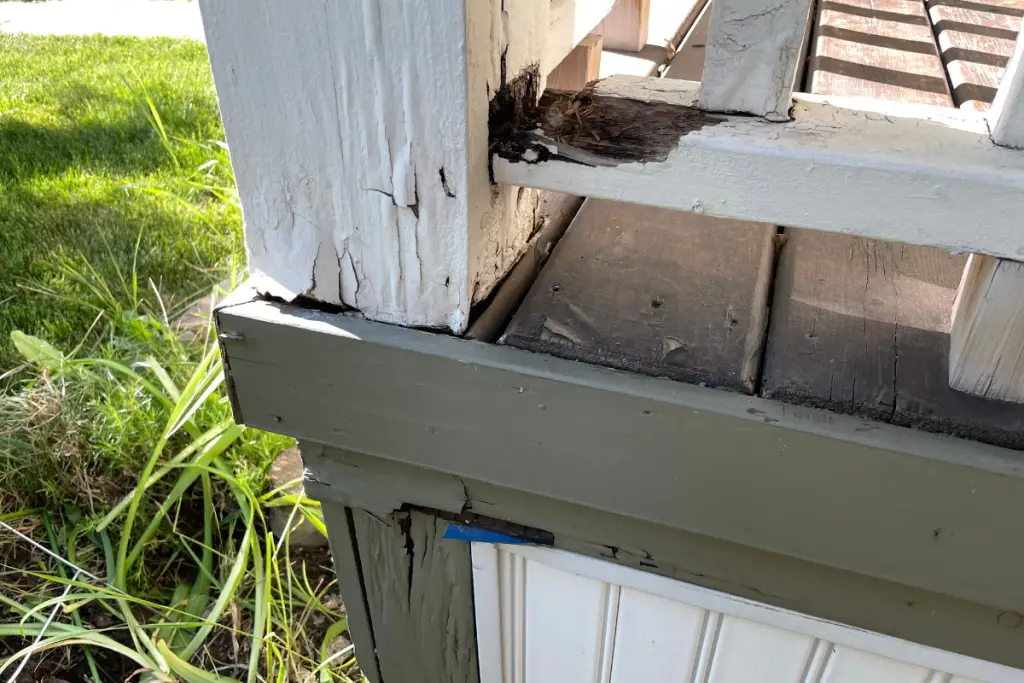
Composite material requires less maintenance than wood but is similar in appearance and requires little maintenance. The two big drawbacks are price and movement.
Expect to pay roughly 3 times more for composite than pressure-treated wood.
Not as bad as vinyl but composite does need to be installed in a way to allow for movement. This is often done with specialty fasteners which again will cost more.
Plywood is an affordable option for deck skirting but is prone to warping from moisture and humidity. Along with under-deck ventilation needing to be accounted for in the construction.
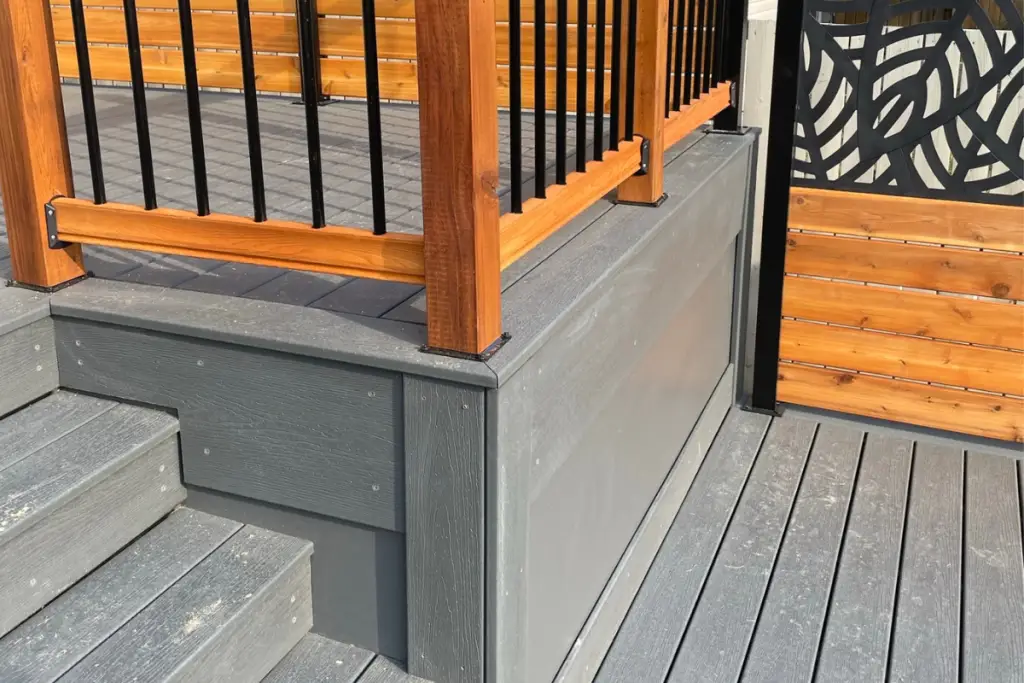
Stucco, brick veneer and stones is a great options for a more custom rustic look and feel, but it can be expensive and time-consuming to install. Additionally, it may require professional installation in order to ensure that it is properly installed and looks good.
Fabric screens are inexpensive for deck skirting, but they are not as durable or attractive as other options. Much more of a temporary fix, for you don’t need to see under your deck this summer, but they will tear within a season or two.
Live skirting, such as shrubs and plants, can look quite nice. You will need to be prepared to invest in ongoing maintenance and upkeep to keep the live skirting looking its best.
Practically it’s a flower garden beside your deck. If you love gardening, this is great. If not, maybe not the best choice.
Conclusion
Deck skirting is an important part of any outdoor space, providing a finished look and helping to protect the area underneath your deck. Many different types of materials are available for deck skirting, each with its advantages and drawbacks.
Vinyl or acrylic panels are affordable but can become brittle in cold weather.
Wood requires significant maintenance
Composite material is more expensive but less prone to warping
Plywood is inexpensive but also warp-prone
Stucco, brick veneer and stone require professional installation for optimal results.
Fabric screens provide short-term coverage at a low cost
Live plants offer beauty but need regular upkeep.
Ultimately, the best material for your deck skirting will need to fit your needs and budget while creating a beautiful outdoor living space that meets all your requirements. And last as long as your deck.
